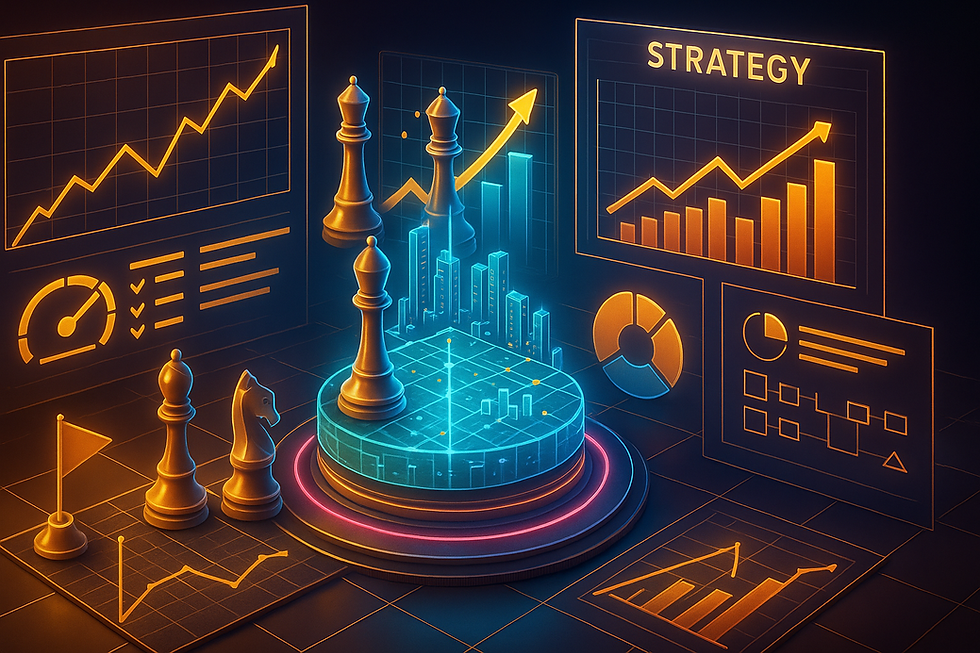Gamification Marketing: Applying Game Elements to Campaigns
- Brand Wise

- Feb 13
- 7 min read

In today’s digital landscape, brands are constantly seeking innovative ways to engage their audiences. One powerful strategy that has gained significant traction is gamification marketing—the process of integrating game mechanics into marketing campaigns. By incorporating interactive challenges, rewards, and competition, businesses can enhance customer engagement, increase conversions, and foster long-term brand loyalty. Whether through point-based loyalty programs, spin-the-wheel promotions, or interactive quizzes, gamification transforms passive audiences into active participants.
The effectiveness of gamification in marketing lies in its ability to tap into fundamental human psychology. People are naturally drawn to competition, achievements, and rewards. When marketing campaigns leverage these elements, they create a more immersive and enjoyable customer experience. But how exactly do these game-like interactions drive engagement and sales? And what are the best strategies for incorporating them effectively? In this blog, we’ll explore the core principles of marketing gamification, real-world examples of successful campaigns, and best practices for implementing these tactics in your own strategy.
Table of Contents
How Game Elements Enhance Marketing Campaigns
Core Gamification Elements in Marketing
Successful gamification marketing relies on strategic game elements that encourage user participation and engagement. Points and rewards incentivize customers by offering tangible benefits for specific actions, such as making a purchase, referring a friend, or completing a profile. Badges and achievements tap into consumers’ desire for recognition, making them feel accomplished when they unlock new levels or complete challenges.
Leaderboards and competitions introduce a social aspect, where customers compete for top rankings, increasing engagement through friendly rivalry. Brands like Nike use leaderboards in fitness apps to drive continuous user participation. Similarly, Starbucks Rewards incorporates progress bars and levels to encourage customers to keep purchasing to reach the next tier of benefits. These elements make marketing campaigns more interactive, reinforcing customer loyalty and brand affinity.
Psychological Triggers Behind Engagement
Gamification works because it aligns with fundamental human psychology. The dopamine effect plays a crucial role—when people earn rewards, complete challenges, or unlock new levels, their brains release dopamine, reinforcing positive behavior and encouraging continued engagement. This is why loyalty programs like Sephora’s Beauty Insider are so effective; they keep customers excited about earning points and reaching higher membership tiers.
Another powerful trigger is FOMO (fear of missing out). Limited-time challenges or exclusive rewards push users to act quickly, driving urgency and participation. Duolingo, for instance, uses streak-based rewards to keep learners engaged daily. Additionally, social validation—seeing friends or peers achieve higher ranks—motivates people to stay engaged. By understanding these psychological principles, brands can design gamified campaigns that feel rewarding and encourage long-term customer interactions.
💡Key Takeaways: Points, badges, leaderboards, and progress bars are core gamification elements that drive engagement. Psychological triggers like dopamine rewards, FOMO, and social validation enhance customer motivation. Successful brands like Nike, Starbucks, Sephora, and Duolingo use gamification to increase user participation and loyalty.
Boosting Conversions with Interactive Rewards
How Rewards Motivate Customer Actions
Rewards are a powerful motivator in gamification marketing, encouraging customers to take specific actions that benefit the brand. Whether it’s offering discounts, freebies, or exclusive content, interactive rewards create a sense of excitement and urgency. McDonald's Monopoly campaign is a classic example, where customers collect game pieces with each purchase for a chance to win prizes. This strategy not only increases sales but also keeps customers returning to complete their game boards.
Another effective reward system is the spin-to-win wheel, commonly used in email marketing and e-commerce. Brands like Sephora and The Body Shop have implemented interactive pop-ups where customers can spin a virtual wheel to win discounts or free products. These small but engaging experiences create anticipation, leading to higher conversion rates and repeat purchases. The key is to make rewards feel attainable yet exclusive, driving customers to engage while maintaining a sense of value.
Case Studies of Successful Reward-Based Campaigns
Several brands have successfully leveraged gamified rewards to boost conversions. Starbucks Rewards is one of the most well-known examples, offering customers stars for each purchase, which can be redeemed for free drinks and exclusive perks. This system not only increases customer retention but also encourages higher spending, as users aim to reach gold status for better rewards.
Similarly, Nike Run Club gamifies fitness by rewarding users with badges, achievements, and challenges that keep them engaged with the app. This encourages continued use of Nike products and strengthens brand loyalty. Chipotle’s “Race to Rewards” campaign also saw significant success, where customers earned points for participating in interactive games, ultimately leading to increased sales and app engagement. These case studies highlight how well-designed reward-based campaigns can drive conversions while keeping customers entertained.
💡Key Takeaways: Rewards create excitement and urgency, motivating customers to engage with a brand. Gamified reward systems like spin-to-win, loyalty points, and exclusive perks increase conversions. Starbucks, McDonald's, Nike, and Chipotle have successfully used interactive rewards to boost engagement and sales.
Fostering Stronger Brand Loyalty with Gamification
Building Long-Term Engagement Through Challenges
Gamification is a proven strategy for building long-term customer engagement, as it creates a sense of progression and achievement. One of the most effective ways to keep customers coming back is through challenges and missions. For example, Nike Run Club engages users by offering running challenges that reward participants with digital badges and achievements. This not only encourages frequent app usage but also strengthens Nike’s community-driven brand identity.
Similarly, Duolingo has mastered the art of keeping users engaged through streaks and leaderboard challenges. By rewarding daily language practice with points and unlocking new levels, Duolingo taps into users’ intrinsic motivation to maintain progress. Challenges like these give customers a reason to return regularly, reinforcing brand engagement while making the experience enjoyable.
Loyalty Programs That Keep Customers Returning
Loyalty programs are one of the most widely adopted gamification strategies because they offer customers incentives to stay engaged with a brand over time. Programs like Starbucks Rewards, Sephora’s Beauty Insider, and The North Face XPLR Pass use tiers, exclusive perks, and milestone rewards to encourage repeat purchases. The more customers spend, the more valuable their rewards become—creating a cycle that drives long-term loyalty.
Gamified loyalty programs also work well in e-commerce. Amazon Prime’s rewards system, for instance, provides exclusive benefits like free shipping and early access to deals, making it more attractive for customers to stay subscribed. In the travel industry, airline frequent flyer programs use levels and status upgrades to keep customers flying with the same airline. These programs create a sense of exclusivity and achievement, which deepens brand loyalty and increases customer lifetime value.
💡Key Takeaways: Challenges and missions (e.g., Nike Run Club, Duolingo) drive long-term engagement by rewarding users for consistent participation. Gamified loyalty programs (e.g., Starbucks Rewards, Sephora Beauty Insider, airline frequent flyer programs) create incentives for repeat purchases. Exclusive perks and milestone rewards make customers feel valued, strengthening brand loyalty over time.
Best Practices for Implementing Gamification in Marketing
Choosing the Right Game Elements for Your Audience
Successful gamification marketing starts with selecting the right game mechanics that align with your audience's interests and behaviors. Different demographics respond to different types of engagement. For example, younger consumers may enjoy interactive quizzes, social challenges, and competitions, while older audiences might prefer point-based loyalty programs with straightforward rewards. Brands like Duolingo use streaks and leaderboards to motivate competitive learners, whereas Sephora’s Beauty Insider program leverages tiered rewards to appeal to beauty enthusiasts.
To implement gamification effectively, brands should focus on simplicity and accessibility. If a game element is too complex, customers may lose interest quickly. McDonald’s Monopoly campaign, for instance, works because it’s easy to understand—customers collect stickers to win prizes, making it fun and engaging without requiring extra effort. Understanding your audience’s preferences will help in selecting the most effective gamification strategies for higher engagement and conversions.
Avoiding Common Pitfalls in Gamification Strategies
While gamification can be a powerful marketing tool, poor execution can lead to negative experiences. One common mistake is offering rewards that lack real value. If customers feel the effort outweighs the reward, they won’t stay engaged. For instance, a spin-to-win discount of just 5% may not be enticing enough to drive conversions, whereas free shipping or a gift with purchase can be more motivating.
Another pitfall is failing to sustain engagement over time. Some brands launch gamified campaigns that generate initial excitement but don’t offer long-term incentives. A loyalty program without progressive rewards can quickly lose its appeal. Brands should continuously update challenges, introduce new incentives, and personalize experiences to keep customers engaged. Successful companies like Nike, Starbucks, and Chipotle regularly refresh their gamified campaigns to maintain customer interest and drive repeat interactions.
💡Key Takeaways: Different audiences respond to different game mechanics—understanding their preferences is key. Simple and accessible gamification elements (e.g., McDonald’s Monopoly) work best for engagement. Rewards should feel valuable and effort-worthy to keep customers motivated. Sustained engagement is crucial—regular updates and new incentives help maintain interest over time.
Conclusion: The Future of Gamification Marketing
Key Takeaways on Marketing Gamification
Gamification marketing has emerged as a powerful tool for enhancing customer engagement, increasing conversions, and fostering brand loyalty. By leveraging game elements such as rewards, leaderboards, challenges, and loyalty programs, businesses create immersive experiences that encourage active participation. Brands like Nike, Starbucks, Duolingo, and McDonald’s have successfully implemented gamification strategies to keep customers engaged and invested over time.
The key to a successful gamification strategy lies in understanding the target audience, offering valuable rewards, and maintaining long-term engagement. Simplicity and accessibility play a crucial role in ensuring customers stay motivated, while continuous updates and personalized incentives help sustain interest. Businesses that integrate these principles effectively can turn occasional customers into loyal brand advocates.
Predictions for Gamification Trends in Marketing
The future of marketing gamification is set to become even more innovative with the rise of new technologies. AI-driven personalization will allow brands to tailor gamified experiences based on user behavior, ensuring more relevant and engaging interactions. Additionally, augmented reality (AR) and virtual reality (VR) will provide immersive game-like experiences, blurring the lines between entertainment and marketing.
Blockchain-based reward systems may also become a trend, enabling secure and transparent digital loyalty programs. Meanwhile, social and interactive gamification elements—such as community challenges and live competitions—will drive deeper brand engagement. As consumer expectations evolve, businesses that stay ahead of these trends and continuously innovate their gamification strategies will gain a competitive advantage in the digital marketplace.





.png)
Comments